Stress is not bad.
Life involves stress, and working from a brain-based or trauma-sensitive lens does not mean removing all stressors. In fact, our stress response gives us the cortisol and adrenaline we need for navigating daily life. The little bit of oomph provided by those get-stuff-done chemicals is much-needed!
Living with chronic or toxic stress is a different story.
The human brain’s natural response to high levels of stress is to flip into survival mode, the fight/flight/freeze patterns found in the downstairs brain. That might look like:
- Having a short temper
- Difficulty concentrating
- Low mood
- Foggy thinking
- Irritability
- Apathy
- Feeling numb
- Isolating from others
- Low motivation
- Feeling on edge or anxious
If any of that sounds familiar, this article is for you.
Want to skip the article and grab the CHEAT SHEET? Enter your information below:
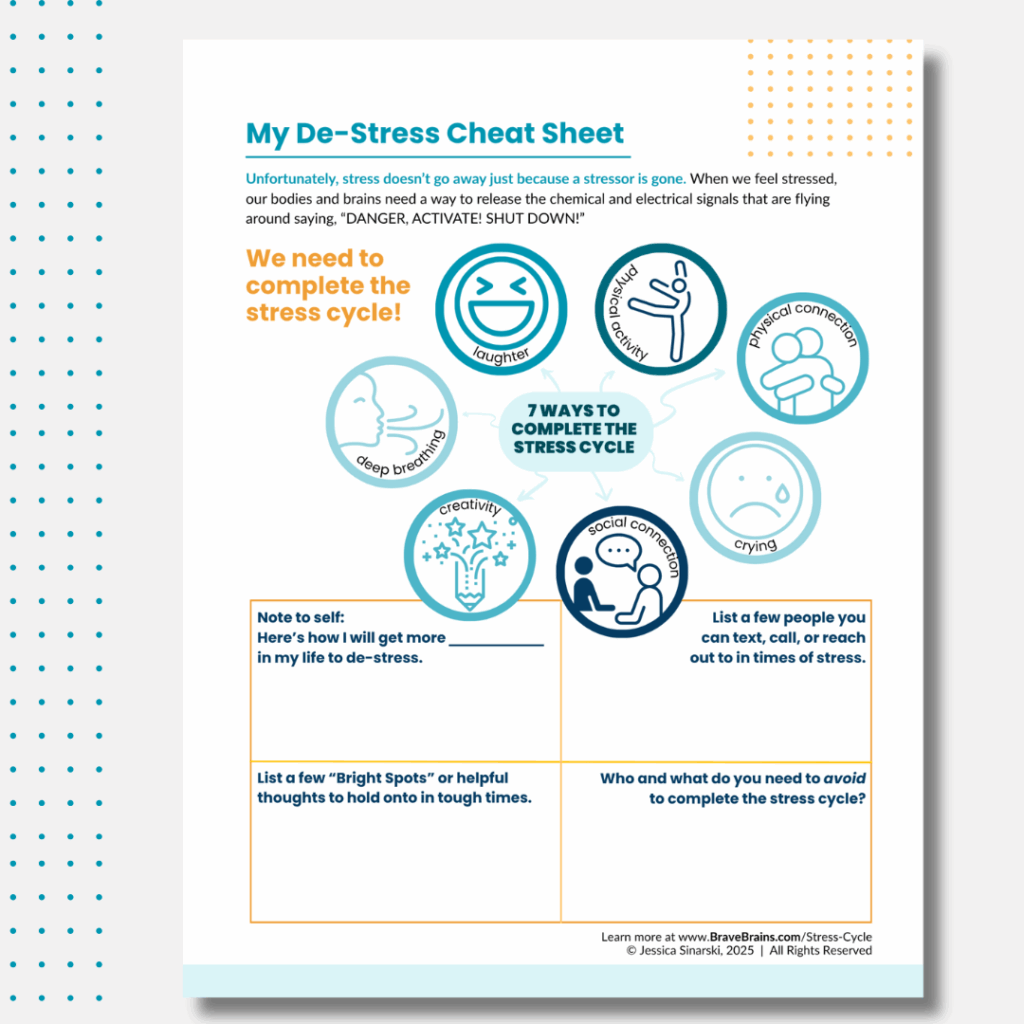
Stressor vs. Stress
Let’s start by clarifying two important terms. According to Burnout authors Emily and Amelia Nagoski…
A stressor can be “anything you see, hear, smell, touch, taste, or imagine could do you harm,” such as work to get done, expectations of others, fear of the future, family issues, etc.
Stress, on the other hand, is “the neurological and physiological shift that happens in your body when you encounter one of these threats.” It’s that cascade of hormones and physical changes that get you ready to fight, run, or survive the danger any which way you can.
Unfortunately, stress doesn’t go away just because a stressor is gone. When we feel stressed, our bodies and brains need a way to release the chemical and electrical signals that are flying around saying, “DANGER, DANGER! ACTIVATE!”
Think of it this way: If you are running late to get out the door in the morning, your heart rate and breath speed up, tension builds, and your porcupine quills might come out when your son still doesn’t have his shoes on. Once he is on the bus and you are on your way to work, the stressor of getting out the door is over, but your body and brain are still pumping all those activating signals back and forth.
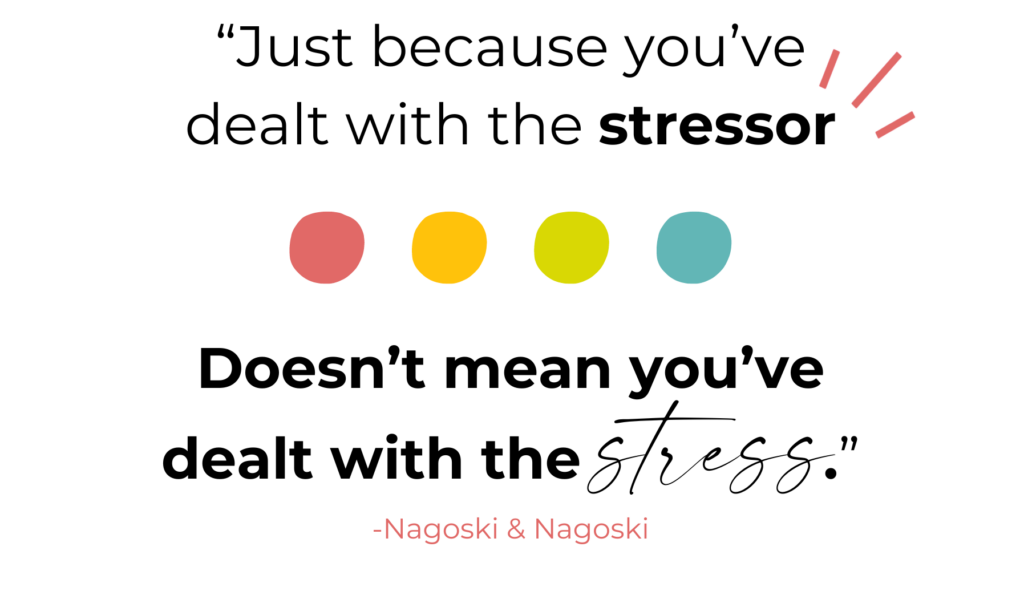
Understanding the (simple) Stress Response Cycle
Reading the scenario above, I am guessing you can come up with a few easy ways to let the stress from the morning go before you head into work, such as:
- A few deep breaths
- Sing along to the music
- Text a friend who gets it
- Take a quick walk before you get on your first zoom call
These simple actions help your nervous system get the little bit of rest and recovery it needs to face the next stressor, a process known as “completing the stress cycle.” Here’s how it works:
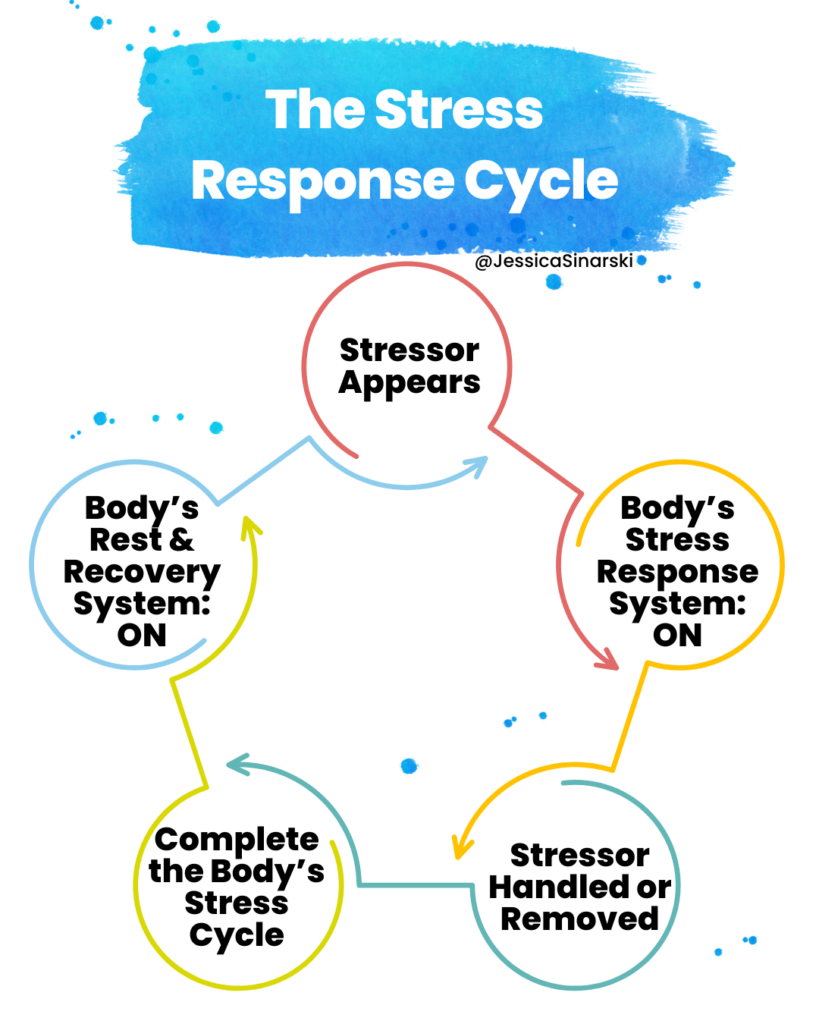
But real life is not so simple.
Teachers face hundreds of little (and some very big) stressors all day long.
Social workers and therapists are called on to intervene in impossibly stressful situations.
Parents of kids with strong Downstairs Brain protectors (and the challenging behavior that comes with) can’t just “remove the stressor.”
It is easy to end up in a pattern that looks like this:
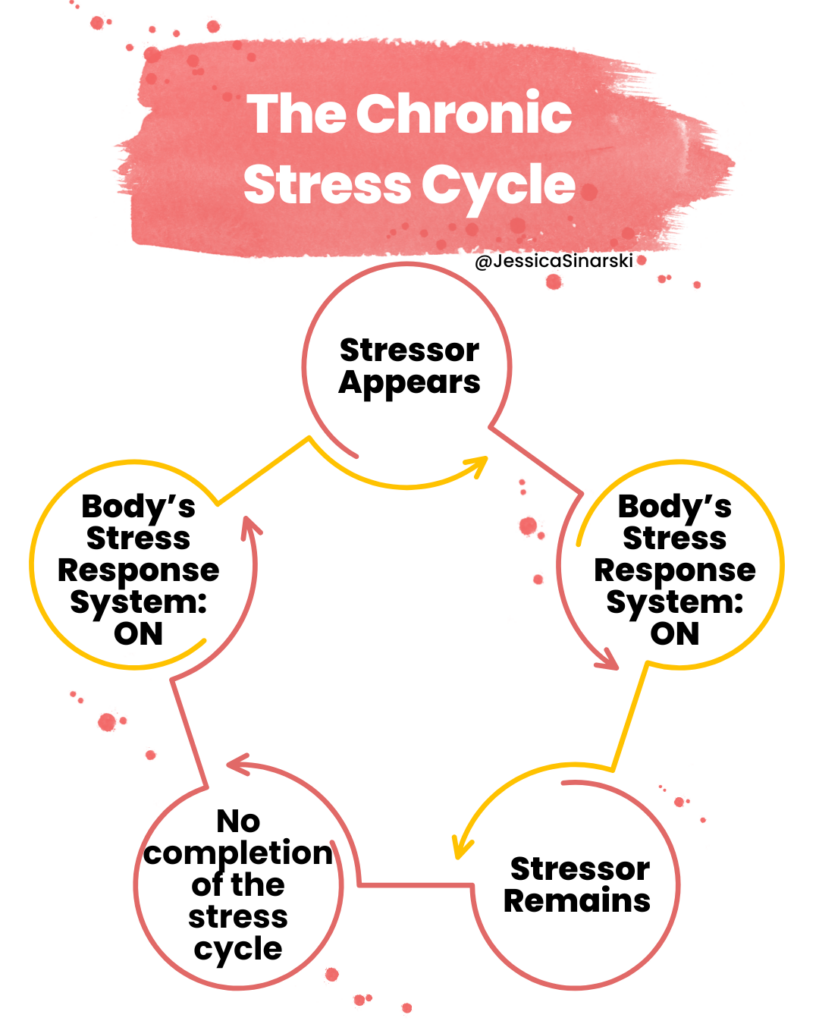
As stressors from family, work, or financial concerns pile up, chronic stress begins to take its toll.
You might feel it in your body as headaches, fatigue, or an upset stomach. Digestion, breathing, and blood flow are all interrupted. Our bodies are responding like the stressed mammals that we are, and the Downstairs Brain tries to run the show.
We need to complete the stress cycle.
A growing body of research shows that there are effective strategies for letting go of some of the stress we carry, commonly called “completing the stress cycle.”
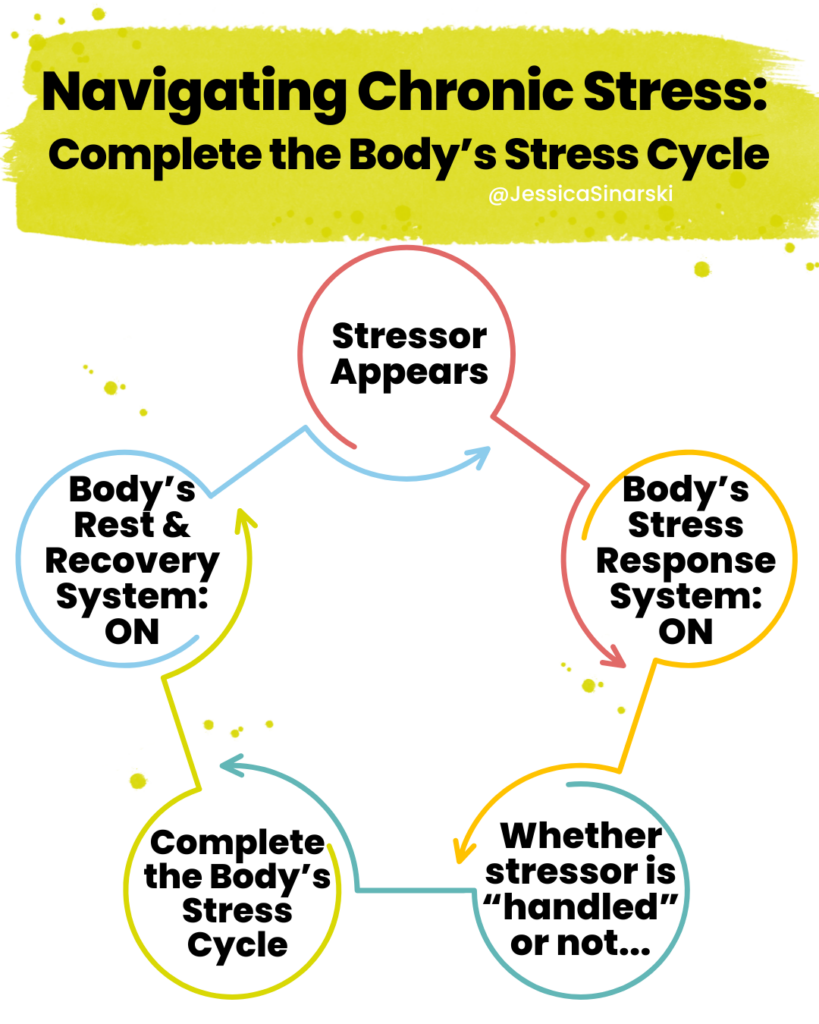
This lets us rest and recover so that we can face the day ahead with our creative, problem-solving Upstairs Brain running the show.
Your Customizable De-Stress Cheat Sheet
Because the stressed brain struggles to hold onto new information, I created a printable cheat sheet to help you climb out of chronic stress. Fill out your information and I’ll send it over!

Use the information from this next section (or your own inner wisdom or help from a trusted friend or therapist) to help build your personalized plan for completing the stress cycle.
7 Ways to Complete the Stress Cycle
Here are seven effective strategies for completing the stress cycle for you to choose from. What are you already doing? What jumps out at you that you might want to explore more? Read on for additional ideas for each category.
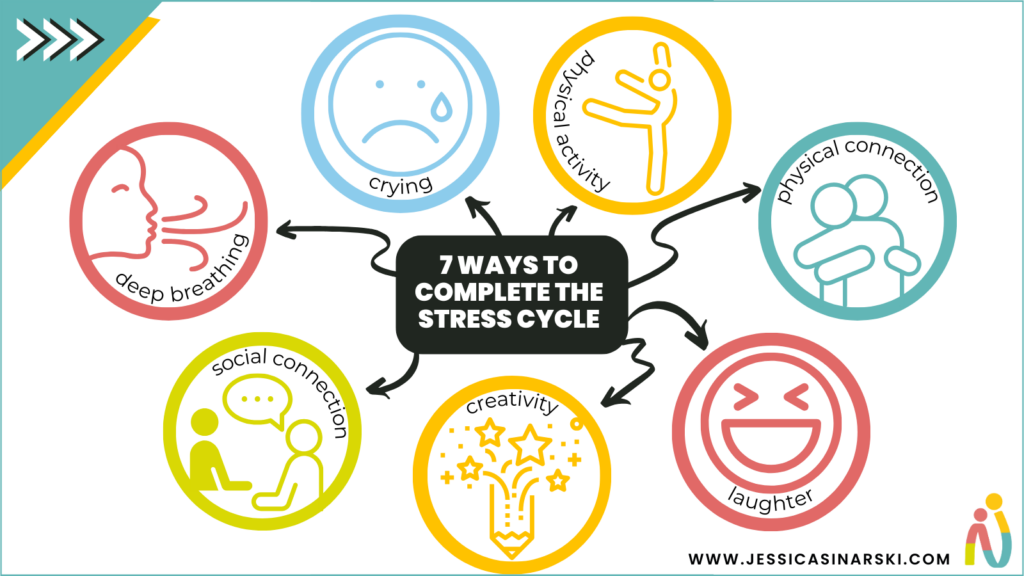
PHYSICAL ACTIVITY
Dance in the kitchen, chase your kids around the playground, or go for a walk or run or swim. Even stomping your feet and screaming or punching your pillow can help! It doesn’t have to be intense physical activity – yoga, stretching, and other gentle practices all have important stress relieving benefits as well.
PHYSICAL CONNECTION
A long, strong hug (about 20 seconds, according to the research) or some snuggle time with a pet can trigger the release of the yummy bonding hormone oxytocin, which sends safety signals to the rest of your body.
LAUGHTER
Those big belly laughs, especially when we share the joy with a friend or loved one, release all kinds of happy chemicals. This is probably why sitcoms have been in constant rotation for me since I started working in foster care 20 years ago. Let yourself laugh out loud! Plus, laughter is contagious. So you might just help someone else complete the stress cycle too.
CREATIVITY
Do you like to knit, paint, bake, sing, write, doodle, or garden? Outcome doesn’t matter as much as the process. Creative endeavors give our brains the chance to experience beauty and messiness and everything in between.
SOCIAL CONNECTION
Social media doesn’t count here. Get the full 3D experience and say hi to another human…at the grocery store, in the hall at work, or even a quick phone call with a friend. It’s a powerful reminder to your upstairs brain that you are not alone with the weight of the world. Deeper social connection like an evening walk with your partner, support group, or gathering of close friends and family are ways to complete the stress cycle so rest and relaxation can kick in, at least for a moment.
BREATHING
Whether a more extensive meditation practice or quick reset, deep breathing is a powerful tool for completing the stress cycle. Anything that gets that exhale longer than the inhale should help the brain get the message: “Hey, we’re ok. No Tiger powers needed right now.” Here’s a simple one I shared on Facebook and Instagram that is great for kids. Another favorite that I often turn to at bedtime is 4-7-8 breathing:
- Breathe in as you count 1,2,3,4
- Hold for 7
- Let your breath out be long and slow as you count down 8,7,6,5,4,3,2,1
CRYING
When is the last time you had a good, ugly cry? My guess is that if you are experiencing chronic stress, there’s some stuff you are grieving. Letting yourself watch a sad episode of your favorite show or listen to a song that brings on the feels might create space for the important physical and emotional relief of a hearty cry.
A Final Encouragement
Over the years, I have heard two common “survival brain” thoughts that hold us back from completing the stress cycle.
“I feel guilty.”
Yes, someone always has it worse than you. And…you’re not going to help anyone out be feeling extra stressed or burning out.
I’m not here to convince you to not feel guilty, but I would encourage you to think about what you would tell a close friend or loved one. Take in that kindness, compassion, and wisdom. Does it apply to you too?
“I don’t have time.”
Try making a 30-second commitment. Choose one option for completing the stress cycle and try it for 30 seconds every day this week. Or maybe you’re ready for 3 minutes. You don’t have to start with an hour!!
Here are some spots in your day that might make it easier to get a habit going:
- Before checking social media
- Before lunch
- First thing in the morning
- Right after the kids are in bed
- When you get in the car to head home
I’m glad we’re in this together!